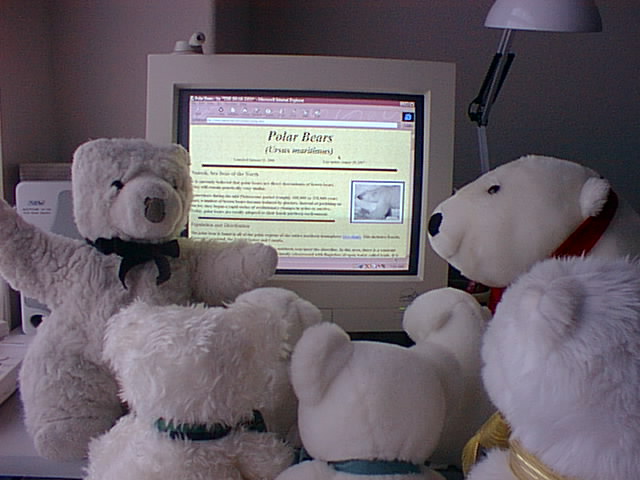Dear bear friends:
 Who were the first humans to reach the North Pole?
Who were the first humans to reach the North Pole?
The Ewer bears are very interested in this question. After all, most of us are polar bears. We are very curious about the arctic region, where real polar bears live.
I am even more curious! I was named "Perry", after Admiral Robert E. Peary, the great arctic explorer. Admiral Peary is generally thought to have been the first human to reach the North Pole.
But was he?
The first people to reach the North Pole may have been early Inuit travelers. The Inuit are Native Americans who live in the arctic region. The Inuit are very skilled arctic travelers.
However, it is unlikely that the Inuit would have visited the North Pole. It is a long way from the open water where the Inuit hunted and fished.
The first person who claimed to have reached the North Pole was Dr. Frederick Cook. He said that he traveled to the North Pole in 1908. One year later, Admiral Peary announced that he was the first person to reach the North Pole, in 1909. Both men insisted that they were first, and a controversy arose. Who would get the credit for reaching the North Pole?
It was difficult to decide! The only proof each man could offer were written records. In 1908 and 1909, there wasn't any other way to tell if either expedition had reached the Pole. Several times, scientific investigations have looked at the records. One investigation was ordered by the Congress of the United States.
All the official investigations decided that Admiral Peary, my namesake, was the first recorded person to arrive at the North Pole. Some scientists still believe that Dr. Cook was first. Other scientists don't think either Cook or Peary reached the North Pole. However, most scientists and all the official investigations have ruled for Peary.
But was Peary truly first?
Peary did not travel alone. In recent years, the story of the 1909 expedition to the North Pole has focused on the other American who made the trip: Matthew Henson. Matthew Henson was an African-American who was Peary's assistant and fellow explorer. Racial prejudice kept Henson from receiving the recognition he deserved as an arctic explorer.
Henson had many valuable skills necessary for the tough arctic voyage. He was a good mapmaker. He learned to speak Inuit. The Inuit taught Henson many arctic survival skills: how to break trails, build a camp, repair sleds, drive a dog team, and hunt polar bears!
Henson and Peary made five arctic journeys together before they attempted to reach the North Pole. In 1902, Henson and Peary made their first polar trip. The expedition ended early because the team ran out of supplies. A 1906 trip ended when a river of open water separated the travelers from the North Pole.
In 1909, Peary and Henson set out for the Pole one more time. They took four Inuit guides and just enough supplies to last for a single trip to the site of the North Pole.
On April 6, 1909, the team reached the North Pole. Many years later, Matthew Henson described what happened on that day. Henson was acting as the trail breaker, traveling ahead of the other members of the expedition. Behind him came the four Inuit pulling a sled. Peary traveled on the sled because his feet were frostbitten.
When Henson's compass began to act oddly, he sat down and waited for the rest of the party. Forty-five minutes later, Peary and the Iniut guides arrived. They made camp at the site. The next morning, Peary verified their position. They had reached the North Pole! As an exhausted Peary watched, Matthew Henson planted the American flag in the ice.
Who was first to the North Pole? No one can say for certain. Still, good evidence supports the claim that Matthew Henson was the first recorded person to reach the North Pole, followed shortly by the other members of the expedition.
Whoever was first to the Pole, the Peary-Henson Polar Expedition was a very difficult, dangerous journey. The group traveled without any modern arctic gear or equipment. It was such a difficult trek that it would be many, many years until another group of travelers walked to the Pole, as did Peary and Henson.
Whether he was first or not, I'm proud to be named after Admiral Robert Peary, arctic explorer!
Your bear friend,
Perry Bear Ewer